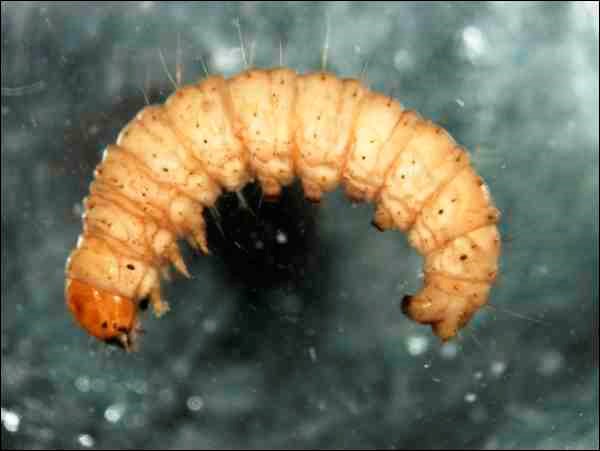My lawn did not survive the winter unscathed. Between the gravel and sand matting down the front lawn, the surprisingly active mouse in the back (that my intrepid cat, Boris, caught as the snow was melting and proudly and promptly brought indoors to show me), and the pervasive snow mould, my lawn has never looked worse. I'm sure this is a common story. But those are winter lawn problems. Summer pest problems are mostly due to insects. One of the main culprits is the sod webworm.
Sod webworms are the larval form of small (0.5 - 0.75 inches) brownish-white grass moths, of which there are several species. The moths are active at night, laying their eggs from July to September. They hide during the day in the grass, in shrubs, and on tree trunks, fluttering up in a cloud when disturbed. The moths themselves cause no damage. Instead it is their creamy white to dark grey and light brown headed larvae that cause damage as they cut off the grass blades, pulling them into their silken burrows at or just below the soil surface. Mature larvae can reach up to 0.75 inch long. The young caterpillars overwinter in silken cocoons in the ground and begin feeding again in early spring before pupating and emerging as adult moths in early summer. There are several species whose generations overlap making it seem like the grass moth is active all summer.
Rarely found in a shady lawn, sod webworms are most often found in full sun, on slopes and sandy soils. Symptoms start out as irregular brown patches that appear in mid-summer. Summer heat, drought and poor fertility can worsen the problem. Conversely, a healthy lawn is the best defense. Sufficient water, fertilizer and weed control can greatly reduce the impact of a sod webworm infestation.
To confirm you have sod webworms, check for recently clipped grass, small green pellets (i.e. frass) and fine webbing in the thatch. Like the adult moths, the larvae are nocturnal so you'll rarely see them in the daytime. You can force them to the surface by applying a solution of lemon-scented dish detergent (one to two tablespoons soap per gallon of water) or with a one per cent pyrethrin solution applied in a two by two foot square over an affected area. The larvae should emerge after two to five minutes, allowing you to count them and determine their size (the smaller they are the easier to control). Concentrate your efforts on the edge of an affected patch as this is where they will be most active - they will have already moved out of the middle of the brown patch as there will be little for them to feed on.
Two chemicals are registered for control in Canada. One is deltamethrin, a group 3 insecticide. The other is spinosad, a natural product derived from a soil organism and is approved for organic agriculture. A third option is a biocontrol agent - a naturally occurring entomopathogenic nematode, Steinernema carsocapsae. It may be available in a concentrated solution at some garden centres and through online mail-order companies.
The chemical deltamethrin is not available for domestic or home use. Instead, carbaryl (available as Grubout and Grub-B-Gone) is available for domestic use. Spinosad, a relatively new control option, may be difficult to find locally. Look for Conserve 120 SC Naturalyte Insect Control Product.
Apply all control options according to label instructions. The best time to apply any of these controls is as late in the day as possible, as close to when the larvae emerge from their protective silken burrows to begin feeding.
- This column is provided by the Saskatchewan Perennial Society
Announcement: Gardenline is open for the season. "From the expert gardener to the first timer or even commercial businesses, all questions are welcome," says MaryLee McArthur, GardenLine co-ordinator with the College of Agriculture and Bioresources at the University of Saskatchewan. Call 306-966-5865 (long-distance charges apply) Monday to Thursday until Aug. 31. Or send your questions to [email protected].




